Initial symptom on upper leaf surface is typically light green to yellow areas, often angular in shape being bounded by major veins due to the pathogen not growing through the veins. This symptom is also typical for some other downy mildew diseases. Diagnostic white, fuzzy growth of the pathogen develops typically on the lower surface under these lesions. Some other downy mildew pathogens produce purplish brown to dark gray spores (e.g. basil and cucurbit). Affected tissue eventually turns brown. Older leaves often are affected first. Following two photographs are of leaves from field-grown crop taken on 28 Oct 2003.
Following image shows that early in infection spores may be present with no visible yellowing of leaf tissue and that spores can develop on the upper surface of leaves. Leaf is from garden-grown lettuce on 1 Nov 2017. Putting leaf upside down on wet paper towel in a sealed ziplock bag overnight is a good way to encourage sporulation to determine if yellow spots lacking spores are due to downy mildew.
Yellow spots visible on the upper leaf surface with spores beneath on the lower surface were also seen on 1 Nov.
Spores can be present more generally on the upper and lower surface similar to powdery mildew, but not as fluffy and lacking mycelial growth on the leaf surface. Look closely at the whole leaf below to see. This was observed on 27 Nov on plants growing outdoors. Light levels are low in fall and plants were covered with winter covers overnight and during cold days.
Disease cycle
Potential initial sources of the pathogen include spores dispersed by wind from other lettuce plantings, plant debris when previous lettuce crop was affected, and contaminated seed; however, the risk of infection from contaminated seed is not known. Downy mildew pathogens have narrow host ranges (the one affecting lettuce is not the same as the one on spinach) and they are obligate pathogens, meaning they need living host tissue to survive unless they are able to produce a specialized spore (oospore), which requires presence of two strains of the pathogen of opposite mating types because oospores are the result of sexual reproduction.
Management
Select resistant varieties.
Conventional fungicides labeled for this disease that can be applied in field and greenhouse include: Actigard, Aliette, copper (check label as some products are not permitted used in greenhouses), ProPhyt and other phosphorous acid fungicides, Ranman, Revus, and Tanos. Additional fungicides that can be applied only to field-grown crops include Forum, Cabrio or Quadris, Orondis Ultra (which also contains same active ingredient that is in Revus), Presidio, and Previcur Flex.
Organic fungicides include copper, Actinovate, Cease, Double Nickel, LifeGard, Oxidate, Regalia, Serenade, Sonata, Timorex Gold, Trilogy, and Zonix.
Please Note: Fungicides mentioned are for use in commercial production, not gardens. The specific directions on pesticide labels must be adhered to — they supersede these recommendations if there is a conflict. Any reference to commercial products, trade or brand names, is for information only; no endorsement is intended. For up-to-date information on labeled conventional fungicides see Cornell Integrated Crop and Pest Management Guidelines for Commercial Vegetable Production and biopesticides see the Biopesticides website.










